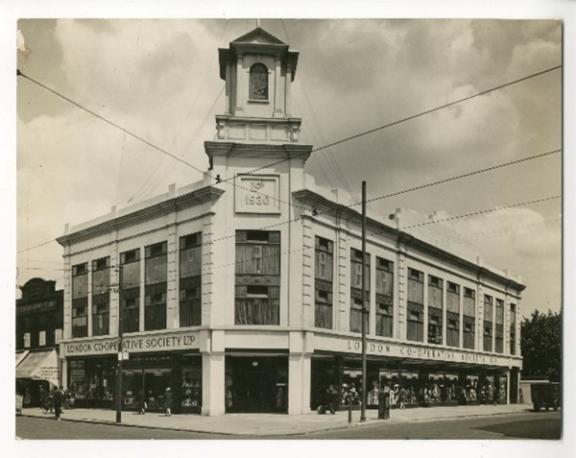A ‘Co-operative’ Community
The Co-operative movement began when the first Co-op opened in Rochdale in 1844. Good quality products could be purchased at a decent price, at a time when living conditions in the North of England were especially difficult. By 1900, the Co-operative model had found success countrywide, encompassing wholesale food stores as well as supporting trade unions, labour bodies and other community organisations. In 1920 the London Co-operative Society was founded.
Previously known as the London Co-operative Society Store, the Co-op on the East side of Tottenham High Road was known as the ‘Edmonton Co-op’. It wasn’t until 1930 that the building was enlarged and a tower with a flagpole was added, proudly looking over the corner of the High Road where it meets Lansdowne Road. The shop was opened by Robert C. Morrison MP for Tottenham as the new departmental store for the local area.

(The London Co-operative Society Store when it opened in 1930. From the collections and © of Bruce Castle Museum and Archive)
Although the Co-op is no longer there on this site, many locals recall visiting this iconic Tottenham store. Some memories are preserved by Bert Hawkes’ ‘Tottenham Shops – A Personal Memory’. Bert was born in the early 1900s and documents his family’s ‘loyalty to that great movement’ – meaning the Co-operative. He recalls the flagship store on the High Road – ‘…my first visit to that Co-op was as a boy was sent to buy a loaf there […] The store also sold carpets, furniture, hardware and drapery.’ The toy department along with the appearance of Father Christmas every year was very popular with local children! As Bert says, ‘when the rainbow flag of the Co-op was flying, it certainly made a lively landmark’.
The Tottenham Co-op store closed around 1981. Many locals felt the loss of a ‘major Tottenham store’, said Ed Spring writing for the North East Tottenham (NET) paper in 1981.
Phoenix Rising from the Ashes
Look up high and you can spot the date-stone ‘1930’ sits atop the old Co-operative store tower (the shop is now ‘Sports Direct’). However, the current building you see today is, in fact, only just over 10 years old.
The riots of 2011 saw the Co-op building destroyed by fire. The dramatic images in the aftermath became emblematic of this particular time. Much like the immortal mythological creature, the Phoenix, this much-loved building on Tottenham High Road proudly rose again from the ashes. A picture of the original building from 1930 from the collections of Bruce Castle Museum and Archive was used for reference in its careful reconstruction.

(The day after the riots of 2011. From the collections of Bruce Castle Museum and Archive)
A community healing
People’s World Carnival Band
Rebuilding the Co-op building became a symbol perhaps to the wider community of the healing that took place across Tottenham after the summer of 2011. Communities in Tottenham came together post-riots to tackle the area’s negative reputation and instead contributed to showcasing and celebrating Tottenham’s rich, diverse, and vibrant creative industries. Below are just a few examples of these community-led creative initiatives:
In 2012 the People’s World Carnival Band, Tottenham’s radical mas band in the Trinidadian tradition (based at the former Whitbread Brewery), chose the theme ‘Fire and Ice’ for their costumes for parading. Their interpretation was a response to the Tottenham riots of the previous year. Fire costumes were developed using the colours red, yellow and orange, depicting Fighting, Injustice, Rebellion and Explosion. Ice costumes were in contrast pale blue, white and silver, and depicted Improvement, Community and Expansion. Drawn from Greek mythology, the Phoenix was chosen as the legendary bird that obtains new life by rising from the ashes of its predecessor. This costume represents the aspirations of local people for Tottenham to rise again like a phoenix from the ashes.

(‘Ice’, 2012. Courtesy: People’s World Carnival Band)
Everybody Dreams
One year after the riots, the amazing local musician and teacher Ty Lowe partnered with nfrom Gladesmore Community School to write, record and produce ‘Everybody Dreams’ – a song to change the negative perception of Tottenham post-riots. The song gathered national television coverage on ITV and the BBC, as well as numerous radio interviews with the BBC. Dave Stewart of the Eurythmics backed Gladesmore to try and get them to number 1. Their song peaked at number 33 on the iTunes chart and top 75 in the UK official charts. You can watch the official music video of ‘Everybody Dreams’ on Youtube.

(Courtesy: Gladesmore Community School)
Tottenham Takeover
A few years after the riots in March 2014, the ‘Tottenham Takeover’ Lates at the Victoria and Albert museum, took over the whole of the V&A Museum to present art, design, music and much more. This included, amongst many other projects:
- The Haringey Recovery Photo Project, looking at Tottenham through the eyes of people in recovery
- Do Well and Doubt Not, a fanzine for Tottenham people to have their say on the area, celebrating the good and addressing what can be improved. Produced by the utopian regeneration agency Spacemakers
- A workshop run by Blingwear, where people could develop their own graffiti style and customise a cap. Blingwear is a Tottenham-based project that runs community workshops and training programmes and promotes graffiti as a positive art form
- A performance by Tottenham Community Choir, who also put on a benefit gig in 2011 for those affected by the riots

(Artwork for Tottenham Takeover at the V&A souvenir programme, by London-based illustrator Edward Carvalho Monaghan. From the collections of Bruce Castle Museum and Archive)
Location
Co-operative Corner
636-638 High Rd
Tottenham
N17 0GA
United Kingdom
